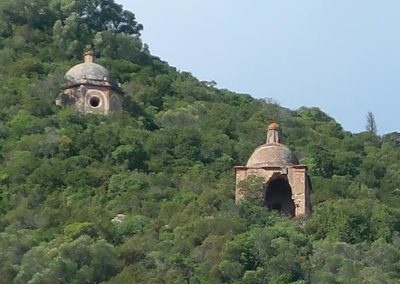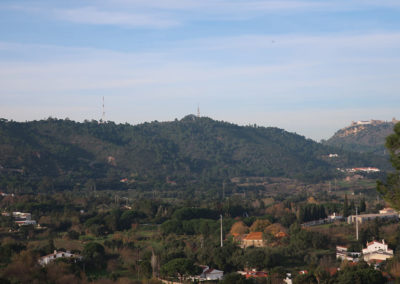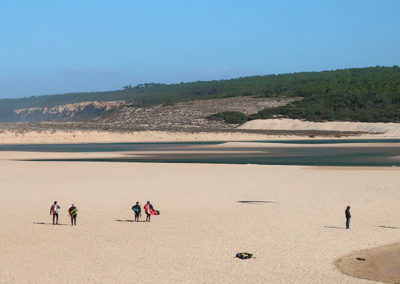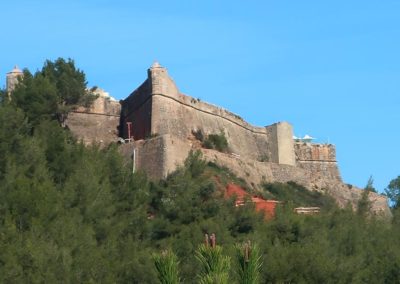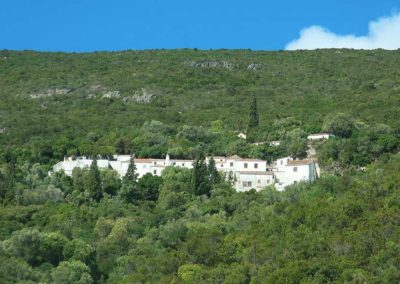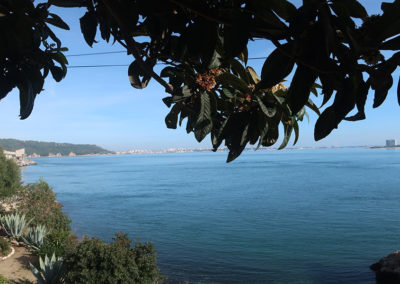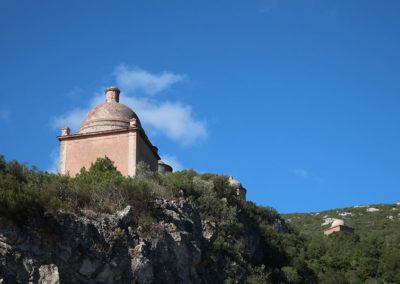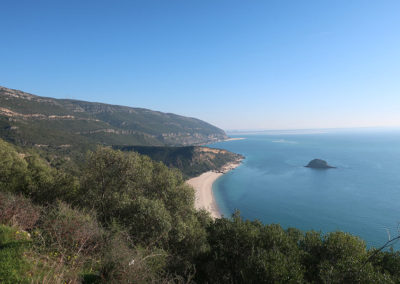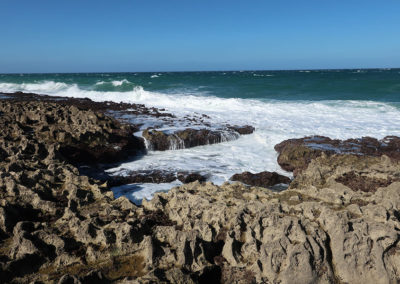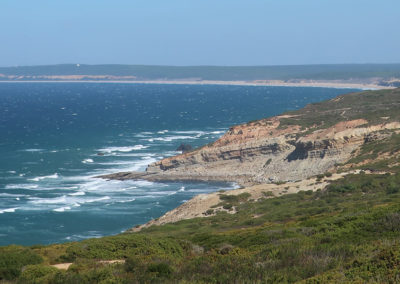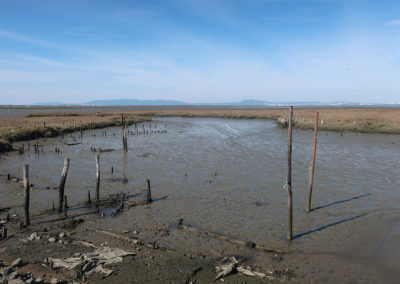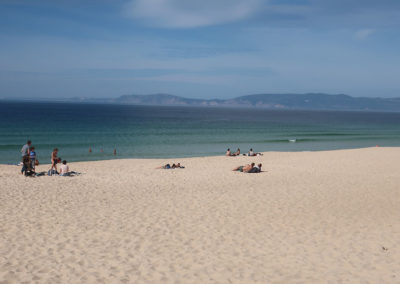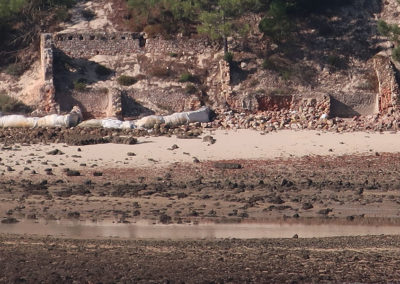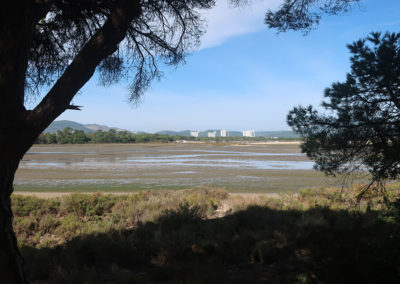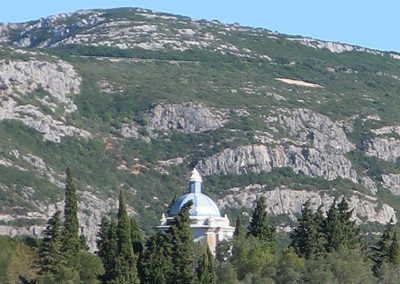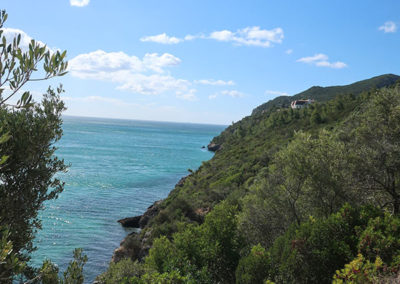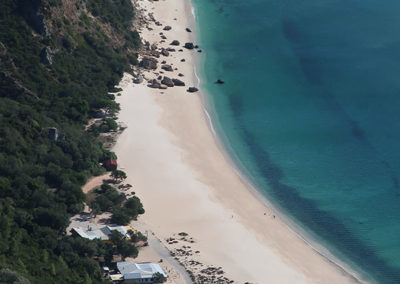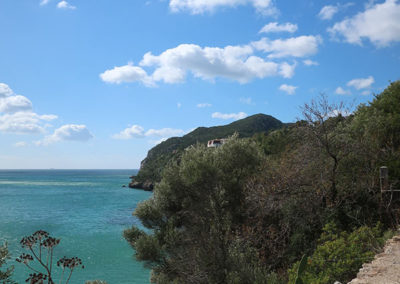The Region
Palmela / Azeitão / Sesimbra
The Landscape
The Landscape
Palmela
This ancient village, with white houses and narrow streets, has as an essential visit spot in the headland where its old Moorish castle is located, from there you can enjoy breathtaking views of either the valley with several streams that drain into the River Sado and go across Setúbal, heading towards south, or to the plain that extends north toward the Tagus River, passing through the Coina River. Here you can perfectly see Lisbon without the help of binoculars and on clear sky days.
Palmela is a vast and mostly rural council. Vineyards and the grazing of sheep culture prevails, from which comes one of the most famous Portuguese cheeses: The Azeitão cheese. In recent years there has been a great investment in the industry, especially in the automotive sector. In the neighbouring region of Pinhal Novo, where an important railway line is located, there has been an increase in the number of people that have chosen to take up residence there.
We strongly recommend you visit the wine cellars of the several wine producers located there, as well as the wine shop and regional products that belong to the City Hall, located on a square right next to the Municipal Library and in front of the stunning Cine-Theatre. We also recommend a visit to the tile workshops, to some of the fine decoration shops (in particular “As Tralhas da Avó”), the Quinta do Anjo caves (Neolithic age funeral monument), and the Museu da Música Mecânica, a museum that contains one of the most important mechanical music collections in the world.
This village is associated with six different cities, Santiago do Cacém, Portugal, two Spanish and Cape Verde (one of which Praia) cities and one in Poland.
4ª Sonata - Allegro


Azeitão
The Azeitão parish, including the Vila Fresca, Vendas, Brejos e Vila Nogueira de Azeitão localities, is known for several “good” reasons: José Maria da Fonseca, has its headquarters in Azeitão and is one of the most emblematic winemaking Portuguese companies, you can visit the cellars where some world famous moscatel wines are produced; it makes artisanal sweets such as Esses de Azeitão, Tortas de Azeitão (egg custard roly poly) and sweet cheeses; it bears many interesting antique shops; it is filled with old small palaces, some already restored, some turned into restaurants, some turned into hotels; it has many farms, some of which host rural tourism or high quality housing.
All in all it is a very quiet place, with a certain air of aristocracy, typical of monarchy eras. The Quinta da Bacalhôa Palace is a Renaissance style building and was once owned by a son of King John I of Portugal, then by Duke of Viseu, one of Dom Afonso de Albuquerque, and finally by an American multimillionaire Orleana Scoville before being acquired by its current owner, the Berardo Foundation.
Located at the crossroads of the road that connects the three castle region (Setúbal, Palmela and Sesimbra) is a must visit place.

Troia
This peninsula, encompassing more than 20 km, is separated from the city of Setúbal by Sado’s estuary. Administratively linked to the Municipality of Grândola, its history is inextricably connected to the city of the Rio Azul (blue river) and capital of the District. One of the reasons is that in both places you can find Roman remains that attest that both places were important centers of fish paste production, a delicacy then called garum, and exported to the whole empire, being appreciated by the elites of that time.
Another social phenomenon that highlights this remote connection is the pilgrimage that the fishermen of Setúbal make every year to the Nossa Senhora do Rosário de Troia chapel, which dates back more than five centuries and takes place between the 17th and 19th of August. This fishing tradition has had, throughout the centuries, a major role in the region, as evidenced by the large number of canning factories that existed in the first half of the 20th century, including one dedicated to manufacturing cetacean oil, which was captured near Cape Espichel and was very active during the 1920s.
Troia is currently mainly sought-after for tourist reasons all year round. It has a casino, several modern hotels, apartments and houses for rent or purchase, a golf course and a magnificent beach lined and protected by rows of dunes covered by beautiful Mediterranean vegetation. It is widely used for holidays, weekends or professional meetings. It has magnificent restaurants and bars, as well as a modern congress center. Herdade da Comporta is also worth a visit, where the excellent rice produced there stands out, as well as the wine, with modern wine cellars where you can have wine tastings.
It is accessible by boat or ferry boat from Setúbal, or by road, either through Alcácer do Sal, or through the road network that runs along the Costa Vicentina. You can practice several sports, including boat trips, where some companies offer, subject to prior reservation, either an unforgettable seafood meal on board, or dolphins and bird watching.
Sesimbra
This picturesque fishing village lies on a difficult access cove; you can get there through steep and winding roads that descend from a headland towards the sea. Everything turns chaotic on the weekend, in particular during the summer because it fills up with hundreds of visitors and tourists, eager to experience one of the most typical settlements of this kind, found in this region and even in the whole country. You can experience the best views in the towering Moorish castle, located on a cliff, overlooking narrow streets. In the distance you can see the sea, sometimes blue, sometimes green, its colours affected by climate conditions, but always stunning. The sea breeze seems to be a constant.
Filled with many, and good, seafood restaurants in whose menu reigns shellfish and the famous fish stew. The sea fortress, once the police headquarters, was recently turned into a municipal museum, dividing the sandy beach into areas, overlooking the sea.
In the surrounding areas you can observe some of the most riviting and tourist-attractive landscapes and points of the Setúbal District. The beautiful Lagoa de Albufeira, the astounding canyon overlooking the ocean (Cabo Espichel), flanked by almost wild small beaches of a rare landscaped beauty. Here, the Nossa Senhora do Cabo Sanctuary deserves a special mention, and visit, where you can see the pilgrims saddles, a century old tradition, and the Pedra Mua cliff, where you will find 150 million years old dinosaur footprints. In the fossil cliff of the nearby beaches you can also find 25 million year old shark tooth fossils (see picture, taken by the author of the text).
In this county you will also find the property and the palace of the descendants of the Duke of Palmela (Quinta de Calhariz), one of the most powerful and traditional families of the region. They once owned a huge land empire, including Serra da Arrábida and its convent (now owned by Fundação Oriente).
This village is associated with twelve cities, including one from each of the following countries: Cape Verde, Belgium, Germany, Denmark, Spain, France, Greece, Ireland, Italy, Luxembourg, Holland and Great Britain.

Author’s private collection

Follow us:

Adress:
Rua Álvaro Castelões, 49 - 1º e 2º
2900-215 Setúbal
Phone: (+351) 919 385 254
E-mail: geral@homematch.pt
Google Translate






